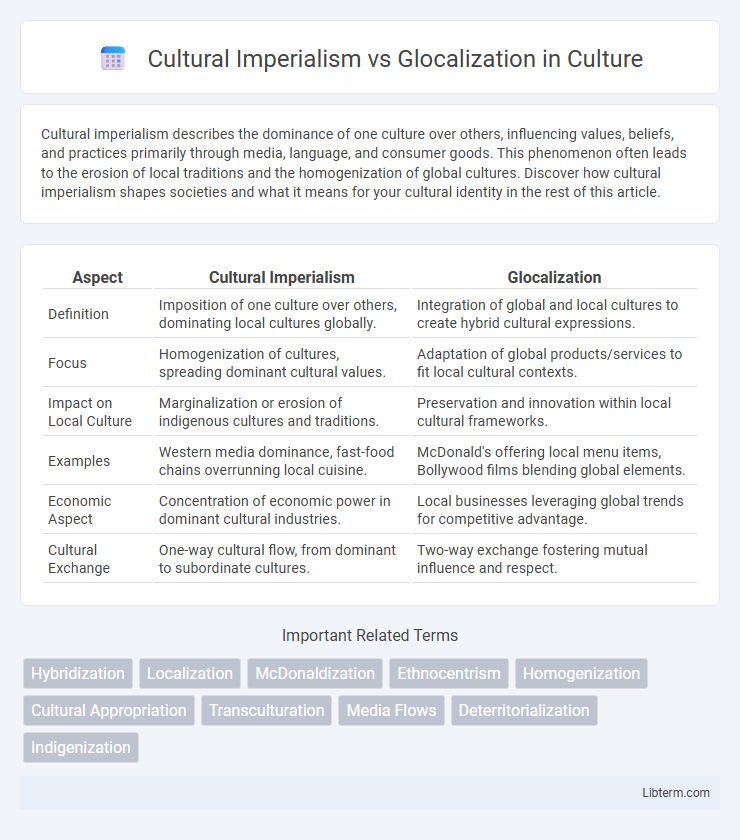Cultural imperialism describes the dominance of one culture over others, influencing values, beliefs, and practices primarily through media, language, and consumer goods. This phenomenon often leads to the erosion of local traditions and the homogenization of global cultures. Discover how cultural imperialism shapes societies and what it means for your cultural identity in the rest of this article.
Table of Comparison
| Aspect | Cultural Imperialism | Glocalization |
|---|---|---|
| Definition | Imposition of one culture over others, dominating local cultures globally. | Integration of global and local cultures to create hybrid cultural expressions. |
| Focus | Homogenization of cultures, spreading dominant cultural values. | Adaptation of global products/services to fit local cultural contexts. |
| Impact on Local Culture | Marginalization or erosion of indigenous cultures and traditions. | Preservation and innovation within local cultural frameworks. |
| Examples | Western media dominance, fast-food chains overrunning local cuisine. | McDonald's offering local menu items, Bollywood films blending global elements. |
| Economic Aspect | Concentration of economic power in dominant cultural industries. | Local businesses leveraging global trends for competitive advantage. |
| Cultural Exchange | One-way cultural flow, from dominant to subordinate cultures. | Two-way exchange fostering mutual influence and respect. |
Understanding Cultural Imperialism: Definition and Origins
Cultural imperialism refers to the dominance of one culture over others, often through media, language, and consumer products, leading to the erosion of local cultures. Originating from colonial and post-colonial contexts, it highlights the power imbalance where Western ideals, particularly from the United States, influence global cultural landscapes. This concept critiques the homogenization effects caused by globalization, contrasting sharply with glocalization, which emphasizes adaptation of global products to fit local cultures.
The Roots and Rise of Glocalization
The roots of glocalization trace back to sociocultural theories emphasizing local adaptations amid global influences, emerging prominently in the 1980s as businesses and cultures sought to reconcile global reach with local relevance. The rise of glocalization reflects the strategic blending of global standardized practices with localized customization, driven by multinational corporations like McDonald's adapting menus to regional tastes and media content tailored to diverse audiences. This phenomenon counters traditional cultural imperialism by promoting cultural hybridity, fostering mutual influence rather than unilateral cultural dominance.
Key Differences Between Cultural Imperialism and Glocalization
Cultural imperialism enforces dominant cultures onto marginalized societies, often suppressing local traditions and leading to cultural homogenization. Glocalization adapts global products or ideas to fit local cultural contexts, promoting cultural diversity and mutual influence. The key difference lies in cultural imperialism's top-down imposition versus glocalization's hybridization and localization process.
Media’s Role in Spreading Cultural Influence
Media serves as a powerful tool in spreading cultural influence by both enabling cultural imperialism and fostering glocalization. Through global broadcasting networks and digital platforms, dominant cultures often impose their values and media content on local audiences, shaping perceptions and lifestyles worldwide. Simultaneously, media enables glocalization by allowing local cultures to adapt, reinterpret, and integrate global content, creating hybrid cultural expressions tailored to regional identities.
Impact of Cultural Imperialism on Local Traditions and Values
Cultural imperialism often leads to the erosion of local traditions and values as dominant cultures impose their norms, media, and consumer products, diluting indigenous identities. This process can undermine community cohesion and result in the loss of languages, rituals, and artisanal knowledge that have been preserved for generations. Resistance through glocalization allows local societies to adapt external influences while maintaining core cultural elements, fostering hybrid identities that balance global and local dynamics.
Glocalization: Adapting Global Trends to Local Contexts
Glocalization enhances cultural relevance by integrating global trends with local customs, language, and values, fostering acceptance and engagement within diverse communities. This approach mitigates cultural imperialism by preserving indigenous identities while benefiting from globalization's economic and technological advancements. Brands and organizations employing glocalization tailor their strategies to meet specific regional needs, driving sustainable growth and cross-cultural exchange.
Case Studies: Cultural Imperialism in Popular Culture
Cultural imperialism in popular culture is exemplified by Hollywood's global dominance, where American movies, music, and fashion shape local tastes and values, marginalizing indigenous cultures. Case studies from countries like India and Nigeria reveal resistance through local film industries (Bollywood, Nollywood) adopting and adapting Western influences to retain cultural identity. This dynamic illustrates the tension between global media power and the preservation of cultural diversity through glocalization strategies.
Success Stories of Glocalization in Business and Media
Companies like McDonald's and Netflix exemplify successful glocalization by adapting global products to local cultures, enhancing customer engagement and market penetration. McDonald's menu variations such as the McAloo Tikki in India and halal options in Middle Eastern countries showcase cultural sensitivity that drives brand loyalty. Netflix localizes content by producing region-specific shows like "Sacred Games" in India and "Lupin" in France, resulting in increased subscriber growth and cultural relevance.
Resistance and Hybridization: Responses to Global Cultural Flows
Resistance to cultural imperialism manifests through localized efforts to preserve indigenous identities, languages, and traditions while challenging homogenizing global media and consumer products. Hybridization emerges as a dynamic response, blending global influences with local cultures to create unique, syncretic expressions in music, fashion, and language that reflect both global connectivity and local specificity. These processes illustrate the complex interplay between domination and agency within global cultural flows, highlighting how communities negotiate, reinterpret, and transform cultural symbols in an increasingly interconnected world.
The Future of Cultural Exchange: Balancing Global and Local Forces
The future of cultural exchange hinges on balancing cultural imperialism and glocalization, where dominant global media influences meet local cultural adaptations. Glocalization enables communities to preserve their unique identities by reshaping global trends to fit local contexts, counteracting the homogenizing effects of cultural imperialism. This dynamic interplay promotes a more equitable cultural landscape, fostering diversity while facilitating cross-cultural dialogue and innovation.
Cultural Imperialism Infographic

 libterm.com
libterm.com